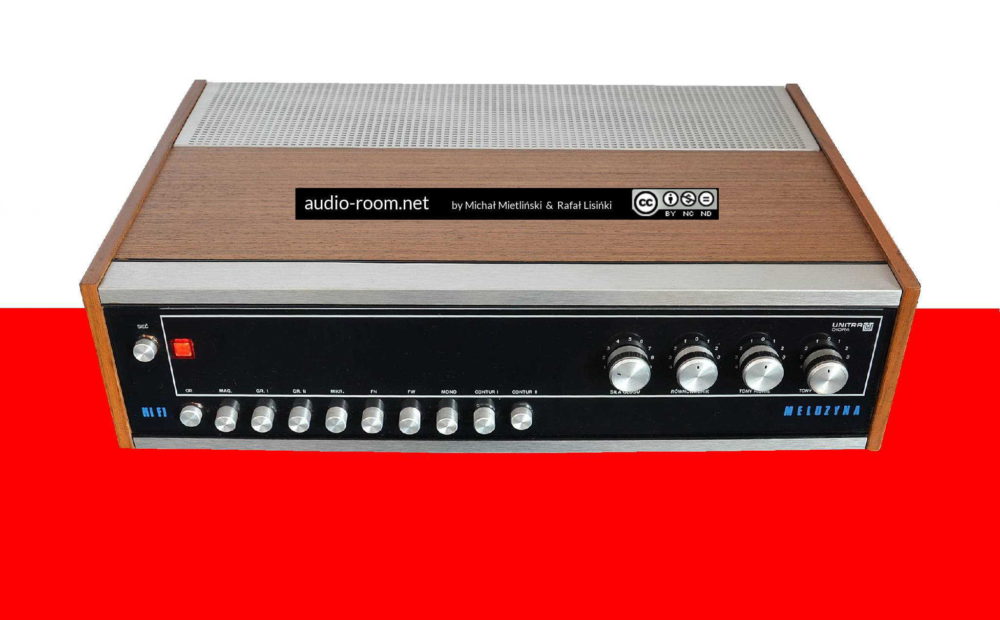On this special day for Poland, here at AudioRoom we decided to celebrate the 46th anniversary of Polish hi-fi and present a very special Polish amplifier: Meluzyna WST-101, manufactured by Diora, part of the Association of Polish consumer electronics manufacturers UNITRA.
WST-101 Meluzyna is a special amplifier for a very simple reason: together with its dedicated tuner and loudspeakers, it formed the first Polish stereo transistor hi-fi set that met the requirements of DIN-45500 standard. The first units were manufactured in 1972. Originally, the main goal of Diora’s management was to present the set at trade shows, did not expect that anyone would want to buy a set that cost the equivalent of several monthly salaries. But the demand turned out to be huge and mass production started in 1973.
The amplifier has a simple, elegant look, probably somewhat inspired by earlier German units (such as Dual). The housing is a veneer box with a metal vent, the front panel is made of black plastic and finished with aluminum top and bottom edges. As for the interior, the design of the first hi-fi amplifier is solid, with good service access, partially shielded transformer and large heat sink, on which we find popular 2N3055 transistors, used in many amplifiers (including the iconic NAD 3020). An interesting solution is the use of a stabilized power supply for the output stage. The goal of the constructors was to reduce the distortion introduced by the output stage. The drawback of this solution is that the stabilized power supply causes the amplifier to have the same continuous power and music power (20 W per channel at 4 ohms).
The amplifier has 2 phono inputs (moving magnet and crystal cart), 2 line inputs (tape recorder and tuner) and 2 microphone inputs. Mic inputs on the rear panel were not very convenient, even less convenient is the lack of a headphone jack. In my Meluzyna a headphone jack has been added – also on the rear panel, which has aesthetic advantages, but is not convenient. Meluzyna has outputs for one pair of loudspeakers, it supports speakers with impedance 4 ohms or higher. Additional features include a mono switch, high and low filters and two loudness modes.
Meluzyna is special for one more reason. It is one of the few Polish amplifiers that I like the sound of. There is no excessive bass rumble and whistling highs typical of products from the times of the communist Poland, the amplifier sounds like a hi-fi amplifier should – quite balanced and pleasant. The frequency range extremes are a bit emphasised, but in the way typical of the 1970s, without exaggeration known from Unitra’s later gear. The sound is clear, with decent soundstage, the vocals sound good, in short everything is in order. Unfortunately, we have not yet had the opportunity to compare it directly with a foreign counterpart, but we plan to do it and we will add the results of the comparison to this article. I am very curious how Meluzyna will sound compared to, say, Kenwood KA-2002, or even Marantz 1060. We can say that compared to the most popular product of PRL-um or Tosca, Meluzyna is almost hi end, not hi-fi.
Diora Meluzyna WST-101 is a great start of Polish hi-fi. It is a shame that what followed (with a few exceptions, such as Meluzyna’s successor – WST-102 Kleopatra amplifier, or very pleasant Fonica PA-107) was 20 lean years, during which Polish manufacturers offered mostly underdeveloped and often simply poorly designed units. We highly recommend Meluzyna, it is not only a very important piece of the history of Polish audio, but also a good amplifier.
Data:
Country Poland
Producer: Zakłady Radiowe UNITRA-DIORA Dzierżoniów
Production years: 1972 – 1977
Continuous power: 2x20W at 4 ohms and harmonic distortion 0.5%
Speakers: min. 4 ohms
Input sensitivity:
OR (tuner): 170 mV, 470 kOhm
MAG (tape recorder): 150 mV, 470 kOhm
GRI (phono MM): 5 mV, 47 kOhm
GRII (phono crystal): 170 mV, 470 kOhm
MIKR I and II (microphone inputs): 5 mV, 22 kOhm
Frequency response: 40 Hz – 20 kHz
Power consumption: 110W
Dimensions: 430 × 270 × 120 mm
Weight: 7 kg

















